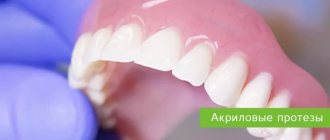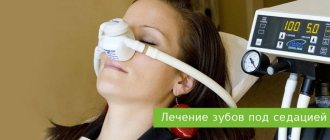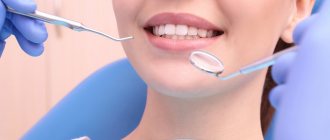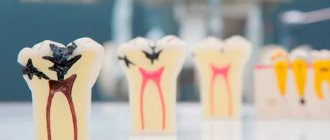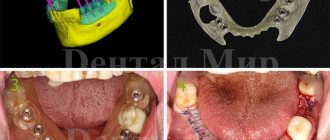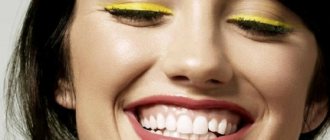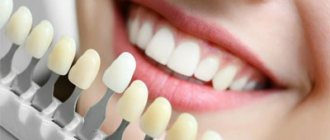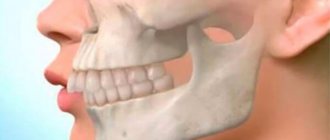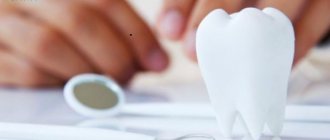Orthodontic dental treatment involves a range of dental services to correct the bite and eliminate related problems. In modern dentistry, this means not only installing braces and making trainers, but also, if necessary, surgical intervention.
One type or another of malocclusion can be diagnosed in most of the world's population. But for some people it causes especially many problems, from a feeling of psychological discomfort caused by uneven teeth, to health problems, for example, frequent diseases of the teeth and gums.
The goal of orthodontic treatment is to correct dental malocclusion.
Whatever method of teeth straightening you choose, you should remember that orthodontic treatment is always a very time-consuming process. Therefore, you need to start it with patience and prepare to wear an orthodontic appliance for a long time.
Methods for correcting bite
Today, dentistry uses two main methods: hardware and surgical. They are radically different and are prescribed for different indications. In addition, orthodontic treatment sometimes uses one combined method, as well as special functional therapy.
Hardware method
The hardware method, in simple terms, is a correction of the bite using removable or non-removable orthodontic structures of braces and plates. Many people have heard about this treatment. It is based on a mechanical effect on individual teeth or areas of the dental system, rebuilding bone tissue. Under mechanical pressure:
- individual teeth move;
- some malocclusions are corrected;
- the ratio of the dentition is normalized.
The orthodontist regulates the force of impact by changing the tension of rubber rods, wire arches, springs and special screws.
Surgical method
In case of pronounced deformation of the dental arches or disproportion of the jaws, the only possible option for correcting the situation will be a surgical method of treatment, an operation to change the shape of the jaw bones. Also, during surgery, you can turn the tooth around.
Hardware-surgical method
In some cases, the device is installed only after surgical preparation. As a rule, this is the removal of excess teeth to provide additional space in the dentition or trimming the frenulum of the tongue.
Functional method
This technique cannot be called completely orthodontic treatment, since it includes special gymnastics for the masticatory and facial muscles, general health measures, and strengthening the body’s natural strengths. Systematic exercises normalize muscle function, ensuring the harmonious development of the skeletal system.
In childhood, these measures have a good effect, allowing you to prevent abnormal development of the bite or completely get rid of it with the help of hardware treatment without relapses in the future.
Dangers of malocclusion
It would seem like a small thing: the teeth protrude slightly or do not close together. But the human body is a single apparatus. Improper functioning of one part leads to failures in others. The dental system is involved in the process of chewing, breathing, swallowing and speech.
Breath
Pathologies of the jaws lead to the fact that a person begins to breathe through the mouth. In children, this leads to insufficient lung volume and frequent diseases of the upper respiratory tract.
When breathing through the mouth, less oxygen enters the lungs, and the chemical composition of the blood changes. This leads to the development of pulmonary and cardiovascular diseases.
Chewing
With a correct bite, the chewing load is distributed evenly. If the occlusion is incorrect, some teeth are excluded from the process, and the remaining ones are subject to additional stress. This leads to tooth decay and periodontal disease. Also, improper load when chewing eliminates some of the muscles, which can provoke problems with the TMJ (maxillary joint)
Swallowing
One of the functions of the tongue is to push food from the mouth into the larynx and beyond. With an incorrect bite, the tongue is positioned incorrectly in the mouth, resting not on the palate, but on the teeth. Due to this, it does not work at full strength, is placed between the teeth, and complicates the orthodontic situation in the mouth.
Speech
With abnormal occlusion, pronunciation suffers the most. The child cannot pronounce some sounds, swallows them, and replaces them with others. It is difficult to understand such children; their diction is impaired and their speech is unintelligible.
During a conversation, certain muscle groups work. With pathologies, some of them are switched off from the process, others are overexerted. This can lead to facial asymmetry.
Posture
Relatively recently, doctors began to pay attention to the relationship between bite and posture. An incorrect bite affects the position of the head. And this, in turn, shifts the center of gravity. The load on the spine changes and back problems, scoliosis and other troubles appear.
Stages of orthodontic treatment
- Diagnosis of malocclusions;
- X-ray examination of the jaw bones;
- selection of dental treatment methods and necessary orthodontic equipment;
- sanitation of the oral cavity, treatment of diseased teeth and gums, professional cleaning, etc.;
- installation of orthodontic apparatus;
- regular observation by a doctor, adjustment of the device;
- retention period to consolidate the achieved result;
- removal of orthodontic equipment.
How is the treatment method chosen?
During the consultation, the problem is initially identified, the necessary clinical data is collected in the form of impressions for diagnostic models, photographs of the face and teeth, and x-rays.
During a visual examination of the patient, the orthodontist identifies a type of anomaly in the position of the teeth and jaws. Then x-ray diagnostics are carried out (panoramic photographs of the jaws and tele-radiography of the head), taking impressions of the dentition and photographing the patient in profile and from the front. Based on the obtained models and the results of X-ray images stored in a special computer program, the doctor determines the causes of anomalies in the position of the teeth and the development of the jaws. Using photography, the impact of this anomaly on facial aesthetics is assessed. After this, the specialist draws up an individual treatment plan, selecting the design of the device and calculating the timing and cost of treatment.
We attach great importance to the future aesthetics of the face and smile, therefore when planning your treatment we consider the most important:
- Preserve the greatest number of teeth; we do not support treatment options that involve preliminary tooth extraction
- Restore the correct function of the corresponding groups of teeth, not limited to banal teeth alignment
- Offer the most comfortable type of orthodontic mechanics; during treatment in our clinic you will have unlimited medical support
- Offer the most convenient and at the same time the most effective equipment
- Use modern treatment technologies: mini-implants, removable transparent Invisalign aligners, Incognito lingual braces
- Carry out mandatory regular hygiene support
- Ensure strict management of the retention period. We are responsible for maintaining your treatment results, therefore, after removing the equipment, the following are required: fixation of retainers and periodic control visits throughout the year.
Types of orthodontic structures
A lot of orthodontic devices have been developed, but they all belong to one of two large groups:
- removable;
- non-removable.
Removable structures
This group includes:
- mouth guards;
- vestibular plates;
- trainers.
Such structures are most often used in pediatric orthodontics to correct the bite of baby teeth.
Among adult patients, special mouthguards for correcting bites are very popular. But these designs are effective only for minor bite defects. Treatment with their help is expensive, time-consuming and useless for serious malocclusions. The choice of teeth straightening technology should be entrusted to a specialist. To do this, you need to sign up for a consultation at a serious dental clinic and certainly not engage in self-diagnosis and self-medication.
Fixed structures
They are mainly represented by fairly well-known bracket systems, of which there are several types, differing in materials and design. Materials used for the production of braces:
- metal;
- ceramics;
- plastic;
- sapphires;
- gold.
Some models of braces are located on the outer side of the dentition, they are called vestibular, others on the inner side, on the side of the tongue, lingual.
Causes of malocclusion
Internal causes include factors that influenced the child before his birth. These are hereditary factors, taking certain medications during pregnancy, and disruption of the endocrine glands.
Ecology, childhood diseases (rickets, etc.), bad habits (finger sucking) are external factors. This also includes an incorrectly selected pacifier when feeding from a bottle. With a large hole, the mixture easily pours out and the muscles do not train, disrupting the bite.
Choice of orthodontic treatment
Since there are so many orthodontic treatment options, there are many to choose from. However, this is not easy to do; you need to take into account a lot of indications and contraindications. A specialist should deal with this issue; the patient has the opportunity to express his preferences. But the final word should remain with the doctor.
- When correcting a child’s bite, removable structures are a very good option. A child's jaw is very pliable; it reacts even to minor mechanical influences of a short duration. Therefore, convenient removable structures can cope with malocclusion development;
- removable orthodontic aligners are an option for correcting minor bite defects. But the defect must be really insignificant, otherwise the mouth guards will be a waste of money. The decision should be left to the dentist;
- To correct a more or less formed bite, braces are the best option. Here the patient has a wide scope; he can choose the materials and type of construction himself. But some restrictions are still present. Despite their high aesthetics, lingual braces are not able to eliminate all dental defects. Sapphire and ceramic systems are fragile and therefore are not very effective against serious anomalies. The opinion of the attending physician when choosing a brace system should remain decisive;
- When correcting serious malocclusions, there are few treatment options. Most often this is a surgical intervention, supplemented by the subsequent wearing of braces;
- For children, functional methods are recommended to prevent malocclusions, as well as correct minor defects.
Installation of braces in Ilatan dentistry
Metal braces are one of the most popular types of correction systems; their main advantage is accessibility and reliability. In addition, metal is a strong and durable material that is easy for a dentist to work with, so installing this type of braces will not take long. There are practically no contraindications for use, except for individual cases of intolerance to the material.
A more modern generation of systems for correcting bites are ceramic braces. They are made of high-tech material – silicon compounds, which have amazing consumer properties.
Advantages of the braces system:
- ultra-reliable,
- stays firmly on the teeth
- very comfortable to wear,
- do not cause any difficulties in operation,
- have a short adaptation period,
- do not change the taste of products,
- do not cause allergies.
But the most important thing is why patients, as a rule, choose them - they are practically invisible on the teeth. The color of the ceramics can be absolutely any; our specialists will make every effort to ensure that the finished structure perfectly matches the color of your teeth.
A type of ceramic braces are sapphire braces. Their second name is aesthetic. They are absolutely transparent, so they are almost invisible on the teeth in any light - even in the neon rays of a nightclub. They are invariably chosen by those for whom appearance is the most important factor. The remaining properties of this type of braces completely coincide with the properties of ceramic ones.
From the experts
In addition to all the above recommendations, experienced orthodontists offer a number of tips based on practical observations:
- For adults, before installing braces, it is better to remove their wisdom teeth, even if they have not yet erupted, since there is a high risk of them being damaged by caries;
- When choosing a doctor, make sure that the examination is thorough. If the orthodontist suggests putting on braces right away, this is a bad sign. However, another recommendation indicates the low qualifications of the specialist - he suggests waiting to start treatment. Most likely, he does not understand how to solve your problem;
- it is very important to treat all teeth before correcting the bite; in addition, you must learn how to clean them correctly so that while wearing braces the enamel does not become caries;
- Soft tissue adjustments may be required before treatment. You should not be afraid of this; if the doctor suggested performing the procedure, then it is really necessary.
Skeptics believe that correcting a bite in adulthood is useless, and braces are only effective on children’s teeth. This is not a completely correct opinion, but in some ways they are right:
- more significant pressure has to be exerted on the teeth of an adult, which leads to painful sensations at the initial stage;
- some teeth have to be removed to make room for others;
- Bridges and crowns have to be removed during treatment, which also does not add pleasant moments to the procedure.
Designs used in orthodontics
It has already been said that in orthodontics, both fixed and removable structures are used to treat dentition anomalies. The doctor who carries out the treatment is obliged to correctly diagnose the anomaly and select the appropriate correction method. If the design is incorrectly selected, the dentition may either not have a positive effect, or the treatment will be extremely ineffective. After installing the structure in the oral cavity, gradual pressure will be applied to the teeth and jaw, which will lead to a complete cure of the anomaly.
Braces
Braces are permanent structures and are the most popular treatment method. A person who uses braces for treatment will wear them for one to two years. The period depends on the degree of the complication and is determined individually, and can also be increased during the treatment process (for example, if the patient misses several appointments with the orthodontist). It should be noted that braces are installed on the teeth using a special material that resembles glue in its action.
The arch, which is installed along with braces, gradually puts pressure on both the jaw and the teeth themselves separately. Thanks to the pressure applied, the teeth gradually move closer or separate, depending on the pathology and the doctor’s prescription. Once every month or month and a half it is necessary to tighten them, since during this time the teeth change their position depending on the doctor’s task.
Thanks to the development of the dental industry, comfortable and unobtrusive braces have appeared. Colored structures were created for children, and transparent ones for adults. Thanks to this development, people who use braces to treat dental defects can use the structure and still lead a normal lifestyle.
Mouthguards for the upper or lower jaw
These mouthguards are an alternative to braces. Such designs are mainly used by adults, since during business conversations the plate can be removed for a while. The devices are completely transparent, which makes their use as comfortable as possible. Their operating principle is the same as that of braces. Mouth guards apply pressure to the dentition, causing the teeth to move towards each other.
Is orthodontic appliance harmful to tooth enamel?
The cause of caries and inflammation of the gums - gingivitis - is dental plaque - a conglomerate of bacteria and food debris that constantly forms on the teeth. The presence of non-removable equipment significantly complicates self-cleaning of the oral cavity. The “immature” enamel of children and adolescents is especially susceptible to carious damage, and above all, the “risk zone” is the areas around the braces.
In this situation, following basic rules of home hygiene and the recommendations of an orthodontist completely eliminates the occurrence of complications such as the appearance of “white spots” on the enamel or carious lesions/cavities and makes orthodontic treatment safe for the patient’s teeth.
Damage to gums and enamel does not occur due to braces, but as a result of poor hygiene. At the beginning of treatment, in addition to recommendations for home hygiene, all patients receive a set of preventive services aimed at strengthening tooth enamel and preventing damage to teeth and gums.
The professionalism of the orthodontist, the competent choice of orthodontic apparatus and close cooperation with the patient are the keys to successful treatment!
Minor “troubles” after the procedure
After the doctor installs a removable device and adjusts it, the patient’s diction is impaired. Don't worry about this - it's completely normal. This occurs due to a decrease in the total volume of the oral cavity. After some time, the language will get used to it. It often takes him a couple of days to do this. To restore your diction, you can read a book out loud.
After the first installation of the device, low pressure is applied to the teeth. It goes away in just a few minutes. But if this does not happen and the patient complains of unpleasant sensations (cutting, pricking), the device must be removed. Only after this you need to get to the dentist as quickly as possible, who will correct the situation. If you delay the procedure, the relief of the mucous membrane will change, making it impossible to put the device back on. This will require ordering a new one and repeating the procedure.
The device must be looked after. It requires cleaning with a special paste at least twice a day. And this must be done with a separate brush. If you ignore this requirement, an unpleasant odor will soon come from your mouth. It is also important to store the device correctly. When dry, it must be placed in a special box. The dentist will give it to you.
How to choose a doctor?
You need to understand that installing removable appliances to straighten teeth is a complex process that only a professional can carry out. Only a highly qualified specialist who has dealt with anomalies more than once can solve this problem. He will talk about the advantages of this method of treatment, its difficulties, and contraindications. The doctor will discuss suitable devices with the patient. Our dental clinic employs such experienced and qualified specialists.
Orthodontist: what does he treat?
In orthodontics, the closure of teeth (dentition) is called occlusion, or occlusion. With normal, physiological occlusion, almost all teeth close to the opposite ones, but with abnormal occlusion, this contact is disrupted. Occlusion disorders can be classified as follows:
- Distal occlusion (the upper teeth protrude far forward relative to the lower teeth).
- Mesial occlusion (the lower jaw protrudes forward).
- Open occlusion (incomplete closure of the upper and lower dentition).
- Cross occlusion (some parts of the lower jaw overlap the upper ones).
- Deep occlusion (the upper incisors overlap the lower incisors too much).
- Crowded teeth.
- Tremas and diastemas (gaps between teeth).
- Anomalies in the position of individual teeth.
- Supernumerary teeth.
